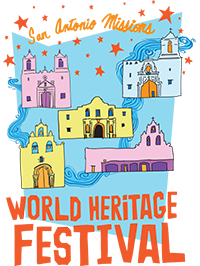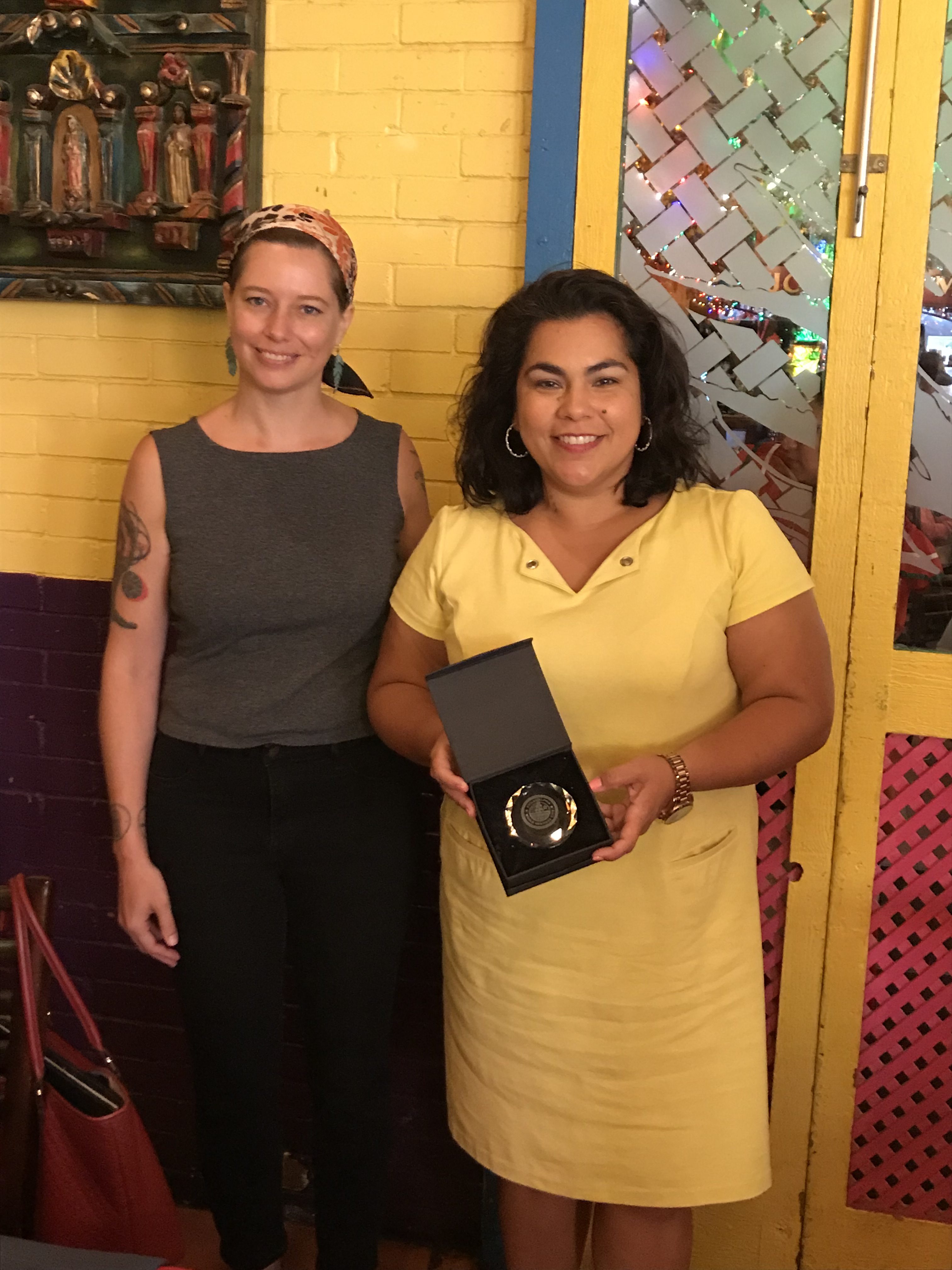Philadelphia and San Antonio: Sharing Best Practices in Heritage Tourism and Public Education
A first grant was given in September 2019 to the City of Philadelphia as part of the OWHC Grants program. The project “Philadelphia and San Antonio: Sharing Best Practices in Heritage Tourism and Public Education” took place during San Antonio’s annual “World Heritage Festival” held September 4-8, 2019. The festival overlaps with the OWHC’s Solidarity Day of World Heritage Cities that occurs annually on September 8th.
Global Philadelphia World Heritage Program Manager Melissa Stevens travelled to San Antonio for the Festival and met with various entities involved in San Antonio World Heritage management to share information and explore opportunities for collaboration. She attended three days of the Festival to learn how San Antonio celebrates World Heritage and communicates its heritage to visitors and residents. She also met with Colleen Swain, Director of the San Antonio World Heritage Office and other colleagues in the World Heritage Office. Other meetings focusing on tourism, public education, and heritage representation were scheduled which included meetings with Visit San Antonio, the National Park Service, Mission Heritage Partners, the Alamo, and American Indians in Texas at the Spanish Colonial Missions.
The OWHC Grant had the objective to strengthen the relationship between Philadelphia and San Antonio, facilitate information-sharing between two of our member cities and the greater OWHC community, and contribute to the OWHC’s mission to encourage co-operation and the exchange of information and expertise and to develop a sense of solidarity among its member cities.
Please find below the project report that Ms. Stevens sent us following the realization of the project:
OWHC City2City Trip Report: Philadelphia’s Visit to San Antonio’s 2019 World Heritage Festival
Melissa Stevens World Heritage Program Manager Global Philadelphia Association
 As the only two “World Heritage Cities” in the United States, Philadelphia and San Antonio share much in common and we have a lot to learn from each other’s unique approaches to World Heritage management and promotion. With funding provided by a new city exchange grant program of the Organization of World Heritage Cities (OWHC), Philadelphia sent a representative to San Antonio for the city’s 4th annual World Heritage Festival this September. The five-day festival celebrates and promotes the San Antonio Missions, a UNESCO World Heritage site, and overlaps with the OWHC’s Solidarity Day of World Heritage Cities recognized annually on September 8th.
As the only two “World Heritage Cities” in the United States, Philadelphia and San Antonio share much in common and we have a lot to learn from each other’s unique approaches to World Heritage management and promotion. With funding provided by a new city exchange grant program of the Organization of World Heritage Cities (OWHC), Philadelphia sent a representative to San Antonio for the city’s 4th annual World Heritage Festival this September. The five-day festival celebrates and promotes the San Antonio Missions, a UNESCO World Heritage site, and overlaps with the OWHC’s Solidarity Day of World Heritage Cities recognized annually on September 8th.
Global Philadelphia Association (GPA) World Heritage Program Manager Melissa Stevens was hosted by the City of San Antonio’s World Heritage Office (WHO) and its Director, Colleen Swain. Dr. Stevens attended three days of the Festival, visited cultural and historical sites, and met with various entities involved in San Antonio World Heritage management and promotion. The trip started off with a tour of the San Antonio Charros Association Ranch, which embodies San Antonio’s living heritage and global connections by performing Charrería, the national sport of Mexico and a grandfather of the rodeo. That evening, Dr. Stevens attended the Festival’s “Music and Movie Under the Stars” at Mission Marquee Plaza, a historic drive-in theater owned by the city and operated as a community space and event venue.
The next day, Dr. Stevens joined WHO staff and hundreds of Festival participants on the Tour de las Misiones, a guided bike, run, or walk tour of the Missions. The evening’s activities included a riverboat trip up San Antonio’s famous River Walk and a viewing of “The Saga,” an illuminated video production displayed on the facade of the San Fernando Cathedral. The last Festival event highlighted the living heritage of the Missions, four of which remain active parishes and central to community life in San Antonio. El Camino de San Antonio hosted a mariachi mass at Mission Espada that was followed by a “green walk” to Mission San Juan, where participants were encouraged to meditate on how they could better care for creation and live sustainably. After the mass, Dr. Stevens was treated to traditional Texan barbecue at 2M Smokehouse. San Antonio became a UNESCO Creative City of Gastronomy in 2017, and the pit masters of 2M were recently selected to represent the city in a traditional barbecue competition in South Korea.

The next day began with a tour of the Alamo to learn about conservation efforts, current archaeology, and the development of a new Master Plan, which seeks to incorporate community input and present the Alamo in a broader context that includes the Alamo’s relationship with the other Missions and its history beyond the famous 1836 battle. Dr. Stevens also met with San Antonio Councilwoman Rebecca Viagran, as well as city officials and partners involved in World Heritage at the famous culinary institution of Mi Tierra in the city’s festive Market Square. Councilwoman Viagran’s district is in the Missions buffer zone and she has been a champion of leveraging heritage assets for local development.
After the Mi Tierra meeting, Dr. Stevens visited Mission San Juan and learned of the San Antonio Food Bank’s farm operation at the Mission. Historically, the missions provided food for the entire community and the Food Bank’s project carries on that legacy. The final day of the trip included a visit to the La Villita Historic Arts Village, a 1939 WPA project, and a tour of the historic Spanish Governor’s Palace, which received a visit from the King and Queen of Spain in 2018.
There were many lessons learned from the trip. San Antonio’s recent UNESCO designations – the 2015 UNESCO World Heritage Site designation and the 2017 UNESCO Creative City of Gastronomy designation – have been a catalyst for development, specifically within the Missions buffer zone. The city’s 2017-2022 Bond Program allocated $37 million to World Heritage-related projects and the comprehensive World Heritage Work Plan includes funds for the Alamo Master Plan, beautification, infrastructure, land use and zoning, transportation, marketing, signage and wayfinding, and small business development. The WHO has also leveraged the Creative City designation to support the growth of the city’s booming restaurant scene, specifically in the Mission buffer zone, and has connected local restantaurs to global opportunities.
These World Heritage related development projects are holistic in nature and include multiple mechanisms for community input and information sharing. As a result, residents are able to directly connect their city’s heritage assets to tangible economic benefits and improved quality of life, which increases community valuation of the Missions and the city’s heritage overall. San Antonio also benefits from the energy and excitement surrounding the recent designations, as well as the active role that the Missions play in the city’s identity and in the residents’ daily lives. As active parishes serving the community in a variety of ways over multiple generations, the Missions continue to be sites of living heritage. Historically, the Missions unified disparate populations when they were established 300 years ago and they continue to be a unifying presence for the city’s residents today.
This trip strengthened the relationship between Philadelphia and San Antonio, facilitated information-sharing between our two cities and the greater OWHC community, and contributed to the OWHC’s mission to encourage cooperation and the exchange of information and expertise and to develop a sense of solidarity among its member cities. We look forward to hosting San Antonio in Philadelphia soon.
For photos from the trip, visit GPA’s Flickr album: https://flic.kr/s/aHsmHqb4QM
News
Together towards the New Urban Project
Technical Assistance and Cooperation
Youth and citizens
Communication


